Research on an Ecological Sensitivity Evaluation of Mountain-Type National Parks Under Multi-Modal Optimization: A Case Study of Shennongjia, China
Abstract
1. Introduction
2. Materials and Methods
2.1. Study Area and Research Framwork
2.2. Research Data
2.2.1. Rainfall Data Optimization
2.2.2. Surface Runoff Coefficient Optimization
- Forest vegetation density is inverted using the remote sensing Kirchhoff Transform formula. Specifically, the sampling point data include 25 existing local sampling points collected by scholars, 20 additional sampling points supplemented by the author through street view photos on Baidu Maps and the well-known domestic outdoor sports website “2bulu” (https://www.2bulu.com/) (accessed on 3 April 2023), and a variety of factors such as the ratio vegetation index, moisture, brightness, and greenness generated from Landsat8 TM’s 30 m data, which are treated as independent variables for the regression and prediction groups.
2.3. Evaluation Model
2.3.1. Biodiversity Protection Evaluation Model
2.3.2. Soil Conservation Evaluation Model
3. Results
3.1. Data Densification Results
3.2. Model Improvement Results
3.3. Comprehensive Improvement Results
4. Discussion
5. Conclusions
Supplementary Materials
Author Contributions
Funding
Data Availability Statement
Conflicts of Interest
Appendix A
| Family Name and Protected Species Names | Species Distribution Data | Habitat Characteristics Summary |
|---|---|---|
| Cercopithecidae (snub-nosed monkey *, Macaca mulatta *) | Local data available (Dalongtan, Qianjiaping, and Jinhouling), non-local data available | Suitable Terrain: Elevations of 1760–2600 m; slope aspects in order of sun-facing, semi-sun-facing; Suitable Vegetation: Sequences of evergreen broadleaf forest, mixed conifer–broadleaf forest, deciduous broadleaf forest, evergreen conifer forest, conifer forest, with canopy density of 30–50%; Distance from Water Sources: 500–2000 m; Human Activity Disturbance: Agricultural land distance >1000 m, human settlements, main roads >2000 m. |
| Felidae (South China Tiger, Leopard *, Clouded Leopard *, Asiatic Golden Cat) | Non-local data available | Suitable Terrain: Elevations of 1600–3000 m; slope <35°; Suitable Ground Surface: Broadleaf forest, mixed conifer–broadleaf forest, deciduous broadleaf forest, with canopy density of 40–57%; Suitable Climate: Annual average precipitation of 500–750 mm, annual average temperature of 3–4 °C; Distance from Water Sources: 500–2000 m; Human Activity Disturbance: Human settlements, main roads >1000 m. |
| Viverridae (Viverra zibetha, Small Indian Civet) | Lack of relevant information, classified according to habitat habits similar to the Felidae family | |
| Ursidae Family (Asian Black Bear *) | Non-local data available | Suitable Terrain: Elevations of 2000–3250 m; Suitable Ground Surface: Sequentially conifer forest, broadleaf forest, canopy density of 56–65%; Distance from Water Sources: 500–2000 m. Suitable Climate: Annual average precipitation of 500–750 mm, annual average temperature of 3–4 °C; Human Activity Disturbance: Human settlements, main roads >1000 m; |
| Mustelidae Family (Sable **, Yellow-Throated Marten, Otter *) | Non-local data available | Suitable Terrain: Elevations of 800–1300 m, slope <15°, aspect sun-facing; Suitable Ground Surface: Sequentially conifer forest, mixed conifer–broadleaf forest, canopy density of 40–80%; Distance from Water Sources: 0–500 m; Human Activity Disturbance: Human settlements, main roads >1500 m. |
| Moschidae and Cervidae Families (Sika Deer *, Forest Musk Deer *) | Local data available (Shennong Peak, Dalongtan, Wangyoutai), non-local data available | Suitable Terrain: Elevations sequentially at 800–1500 m, 2200–3800 m; slopes sequentially >45°, 10–45°; aspect southeast sun-facing; Suitable Ground Surface: Edge of broadleaf forest and mixed conifer–broadleaf shrubbery, vegetation canopy density of 30–60%; Distance from Water Sources: <1000 m; Human Activity Disturbance: Distance from human settlements, main roads >2000 m. |
| Bovidae Family (Serow *, Grey Goral *) | Non-local data available | Suitable Terrain: Elevations of 1600–3700 m; Suitable Ground Surface: Sequentially evergreen broadleaf forest, mixed conifer–broadleaf forest, conifer forest; vegetation canopy density >60%; Distance from Water Sources: <1000 m. |
| Canidae Family (Jackal, Gray Wolf **) | Non-local data available | Suitable Terrain: Elevations sequentially at 900–1000 m, 600–800 m; Suitable Ground Surface: Sequentially evergreen broadleaf forest, mixed conifer–broadleaf forest, conifer forest; vegetation canopy density >60%; Distance from Water Sources: sequentially <2000 m, 2000–4000 m; Human Activity Disturbance: Distance from human settlements 2000–4000 m, main roads 500–1000 m. |
| Pangolin Family (Pangolin *) | Non-local data available | Suitable Terrain: Elevations <400 m; slope of 30–60°; aspect sun-facing, semi-shaded; Suitable Ground Surface: Sequentially mixed conifer–broadleaf forest, shrubbery, evergreen broadleaf forest, conifer forest; vegetation canopy density of 31–70%; Suitable Climate: Annual precipitation >1500 mm; Distance from Water Sources: <500 m; Human Activity Disturbance: Distance from human settlements, main roads >1000 m. |
| Stork Family (White Stork *) | Non-local data available | Suitable Ground Surface: Sequentially marsh, marsh surrounding paddy fields, paddy fields, rivers, and lakes. |
| Ardeidae Family (Hainan Pond Heron **, Hainan Tiger Heron, Great White Egret *) | Non-local data available | Suitable Terrain: Elevations of 110–200 m, slope of 20–30°, southeast to southwest aspect; Suitable Ground Surface: Sequentially marsh, rivers, lakes; Suitable Climate: Temperature range of 0–25 °C, maximum monthly precipitation of 130 mm, minimum seasonal precipitation of 4 mm; Distance from Water Sources: <400 m; Human Activity Disturbance: Distance from human settlements 100–900 m, main roads >200 m. |
| Anatidae Family (Mandarin Duck) | Lack of relevant information, classified according to habitat habits similar to the Ardeidae family | |
| Falconidae Family (Red Falcon *, Black-Crowned Falcon * and other 7 species) | Non-local data available | Suitable Terrain: Cliffs, bare rock with a slope >50°; Suitable Ground Surface: Sequentially farmland, clearings among forests (vegetation canopy density >60%), shrubbery, mudflats; Human Activity Disturbance: Distance from human settlements, main roads >7000 m. |
| Accipitridae Family (Golden Eagle, Crested Honey Buzzard, Kite, Vulture, Steppe Eagle, and 25 other species) | Lack of relevant information, classified according to habitat habits similar to the Falconidae family | |
| Strigidae Family (Scops Owl, Eagle Owl, Pygmy Owl, and 13 other species) | Lack of relevant information, classified according to habitat habits similar to the Falconidae family | |
| Phasianidae Family (Red-Bellied Tragopan *, Blue Peafowl **, SpoonBill, White-Crowned Long-tailed Pheasant *, Red-bellied Tragopan *) | Non-local data available | Suitable Terrain: Elevations of 800–1600 m; slope <30°; Suitable Ground Surface: Sequentially deciduous broadleaf forest, conifer forest, mixed conifer–broadleaf forest, farmland; vegetation canopy density >60%; Distance from Water Sources: <1000 m. |
| Scolopacidae Family (Lesser Sandpiper *) | Non-local data available | Suitable Ground Surface: Water bodies, marshes, mudflats. |
| Columbidae Family (Green-Winged Pigeon, Wedge-Tailed Green Pigeon) | Lack of the relevant information, classified according to habitat habits similar to the Phasianidae family | |
| Pittidae Family (Blue-Winged Pitta) | Lack of the relevant information, classified according to habitat habits similar to the Phasianidae family | |
| Cuculidae Family (Brown-Winged Cuckoo *, Lesser Cuckoo) | Non-local data available | Suitable Ground Surface: At the edge of mixed evergreen-deciduous broadleaf shrubbery, broadleaf forest, mixed conifer–broadleaf forest, riverbank forests, small-scale farmlands. |
| Cryptobranchidae Family (Giant Salamander *) | Non-local data available | Suitable Ground Surface: River mouths with slopes >35° and vegetation canopy density >50% on both banks. |
| Dicroglossinae Family (Hoplobatrachus chinensis *) | Non-local data available | Suitable Terrain: Slope <20°; Suitable Ground Surface: Paddy fields, grasslands; Distance from Water Sources: >200 m from large water bodies, <100 m from small water bodies; Human Activity Disturbance: 100 m from farmland, 100–200 m from roads, >200 m from residential areas. |
| Papilionidae Family (Luehdorfia chinensis *, Two-tailed Swallowtail, Three-Tailed Swallowtail, Luehdorfia chinensis) | Non-local data available | Suitable Ground Surface: High-altitude shrubbery. |
| Carabidae Family (Carabus lafossei, Prosodes dilaticollis Motsch **) | Non-local data available | Suitable Ground Surface: Shrubs, grasslands; Suitable Climate: The minimum temperature of −10–25 °C in the coldest month, driest season average temperature of 0–10 °C, annual average temperature of 10–20 °C, annual precipitation of 0–1000 mm, isothermal temperature of 16–32 °C. |
References
- Schägner, J.P.; Brander, L.; Maes, J.; Paracchini, M.L.; Hartje, V. Mapping recreational visits and values of European National Parks by combining statistical modelling and unit value transfer. J. Nat. Conserv. 2016, 31, 71–84. [Google Scholar] [CrossRef]
- IUCN. IUCN Global Standard for Nature-Based Solutions; International Union for Conservation of Nature: Gland, Switzerland, 2020. [Google Scholar]
- Zhao, Y.; Huang, X.; Zhao, Y.; Liu, X.; Zhou, R. The application of landscape character classification for spatial zoning management in mountainous protected areas—A case study of Laoshan national park, China. Heliyon 2023, 9, e13996. [Google Scholar] [CrossRef]
- Tian, S.; Zhang, Y.; Xu, Y.; Wang, Q.; Yuan, X.; Ma, Q.; Chen, L.; Ma, H.; Xu, Y.; Yang, S.; et al. Urban ecological security assessment and path regulation for ecological protection—A case study of Shenzhen, China. Ecol. Indic. 2022, 145, 109717. [Google Scholar] [CrossRef]
- Yang, D.; Song, W. Ecological function regionalization of the core area of the Beijing-Hangzhou Grand Canal based on the leading ecological function perspective. Ecol. Indic. 2022, 142, 109247. [Google Scholar] [CrossRef]
- Lv, C.; Li, S.; Ling, M.; Niu, Z.; Yan, D. Assessment of water conservation and water intensification level based on AHP-fuzzy comprehensive evaluation model. Desalin. Water Treat. 2024, 319, 100567. [Google Scholar] [CrossRef]
- Ellis-Soto, D.; Chapman, M.; Koltz, A.M. Addressing data disparities is critical for biodiversity assessments. Trends Ecol. Evol. 2024, 39, 1066–1069. [Google Scholar] [CrossRef]
- Masha, M.; Bojago, E. Evaluating soil erosion and determinants of farmers’ adoption of soil and water conservation measures in the Offa district, southern Ethiopia. J. Agric. Food Res. 2023, 14, 100866. [Google Scholar] [CrossRef]
- Xu, Y.; Huang, W.-T.; Yao, Y.-F.; Xu, M.; Zou, B.; Feng, Y.-X. Carbon sequestration in vulnerable ecological regions of China: Limitations and opportunities. J. Clean. Prod. 2024, 475, 143702. [Google Scholar] [CrossRef]
- Cook, D.; Malinauskaite, L.; Davíðsdóttir, B.; Ögmundardóttir, H. Co-production processes underpinning the ecosystem services of glaciers and adaptive management in the era of climate change. Ecosyst. Serv. 2021, 50, 101342. [Google Scholar] [CrossRef]
- Belle, S.; Huser, B.; Johnson, R.K. Cumulative effects of climate change and land use on the ecological status of Scandinavian lakes show contrasted interactions in different ecoregions: The role of pre-disturbance conditions in assessing ecological status. Ecol. Indic. 2024, 169, 112879. [Google Scholar] [CrossRef]
- Liu, J.; Hull, V.; Batistella, M.; DeFries, R.; Dietz, T.; Fu, F.; Hertel, T.W.; Izaurralde, R.C.; Lambin, E.F.; Li, S.; et al. Framing Sustainability in a Telecoupled World. Ecol. Soc. 2013, 18(2), 344–365. [Google Scholar] [CrossRef]
- Lou, Y.; Bian, J.; Sun, X.; Wang, F.; Xu, L.; Sun, G. Optimization of ammonia nitrogen benchmarks and ecological risk assessment in monsoon freezing lakes based on species sensitivity distribution with Lake Chagan in northeastern China as an example. Ecol. Indic. 2024, 166, 112346. [Google Scholar] [CrossRef]
- Nematollahi, S.; Fakheran, S.; Jafari, A.; Pourmanafi, S.; Kienast, F. Applying a systematic conservation planning tool and ecological risk index for spatial prioritization and optimization of protected area networks in Iran. J. Nat. Conserv. 2022, 66, 126144. [Google Scholar] [CrossRef]
- Boughton, W. Calibrations of a daily rainfall-runoff model with poor quality data. Environ. Model. Softw. 2006, 21, 1114–1128. [Google Scholar] [CrossRef]
- Mabuda, M.O.; Shoko, C.; Dube, T.; Mazvimavi, D. An analysis of the effects of changes in land use and land cover on runoff in the Luvuvhu catchment, South Africa. Remote Sens. Appl. Soc. Environ. 2024, 33, 101144. [Google Scholar] [CrossRef]
- Ahmad, T.; Pandey, A.C.; Kumar, A.; Tirkey, A. Understanding the role of surface runoff in potential flood inundation in the Kashmir valley, Western Himalayas. Phys. Chem. Earth Parts A/B/C 2023, 131, 103423. [Google Scholar] [CrossRef]
- Kang, X.; Du, M.; Zhao, L.; Liu, Q.; Liao, Z.; Su, H.; Xiang, T.; Gou, C.; Liu, N. Integrity-centered framework for determining protected areas boundary: An application in the China’s national park. Ecol. Inform. 2024, 84, 102885. [Google Scholar] [CrossRef]
- Bacar, F.F.; Faque, H.B. Forest holds high rodent diversity than other habitats under a rapidly changing and fragmenting landscape in Quirimbas National Park, Mozambique. Ecol. Front. 2024, 44, 175–194. [Google Scholar] [CrossRef]
- Naidoo, L.; Cho, M.A.; Mathieu, R.; Asner, G. Classification of savanna tree species, in the Greater Kruger National Park region, by integrating hyperspectral and LiDAR data in a Random Forest data mining environment. ISPRS J. Photogramm. Remote Sens. 2012, 69, 167–179. [Google Scholar] [CrossRef]
- Wang, Y.; Zhang, X.; Gong, L.; Wang, W.; She, D.; Liu, J. On the relationship between surface runoff and impervious area in the urban RPA (Receiving Pervious Area)-DIA (Disconnected Impervious Area) system: A simple equation expressing the sensitivity of runoff to changes in imperviousness. J. Hydrol. 2024, 631, 130836. [Google Scholar] [CrossRef]
- Assouline, S.; Sela, S.; Dorman, M.; Svoray, T.; Selker, J. A simple analytical method to estimate runoff generation and accumulation. J. Hydrol. 2024, 644, 132053. [Google Scholar] [CrossRef]
- Turunen, M.; Gurarslan, G.; Šimůnek, J.; Koivusalo, H. What is the worth of drain discharge and surface runoff data in hydrological simulations? J. Hydrol. 2020, 587, 125030. [Google Scholar] [CrossRef]
- Wang, F.; Chen, W.; Niu, L. An Improved InVEST Ecological Service Evaluation Model Based on BP Neural Network Optimization. Nat. Environ. Pollut. Technol. 2020, 19, 991–1000. [Google Scholar] [CrossRef]
- Zuo, Y.; Gao, J.; He, K. Interactions among ecosystem service key factors in vulnerable areas and their response to landscape patterns under the National Grain to Green Program. Land Degrad. Dev. 2024, 35, 898–915. [Google Scholar] [CrossRef]
- Jiao, D.; Yan, L. Appraisal of urban land ecological security and analysis of influencing factors: A case study of Hefei city, China. Environ. Sci. Pollut. Res. 2022, 29, 90803–90819. [Google Scholar] [CrossRef]
- Malekmohammadi, B.; Jahanishakib, F. Vulnerability assessment of wetland landscape ecosystem services using driver-pressure-state-impact-response (DPSIR) model. Ecol. Indic. 2017, 82, 293–303. [Google Scholar] [CrossRef]
- Zhang, Z.; Wang, C.; Lv, B. Comparative analysis of ecological sensitivity assessment using the coefficient of variation method and machine learning. Environ. Monit. Assess. 2024, 196, 1000. [Google Scholar] [CrossRef]
- Shamuxi, A.; Han, B.; Jin, X.; Wusimanjiang, P.; Abudukerimu, A.; Chen, Q.; Zhou, H.; Gong, M. Spatial pattern and driving mechanisms of dryland landscape ecological risk: Insights from an integrated geographic detector and machine learning model. Ecol. Indic. 2025, 172, 113305. [Google Scholar] [CrossRef]
- Tong, Z.; Zhang, Z.; Lu, Y.; Liu, Y.; An, R.; Luo, X.; Liu, S.; Zhang, B. Optimization of ecological network function and structure by coupling spatial operators and biomimetic intelligent algorithm. J. Clean. Prod. 2024, 465, 142794. [Google Scholar] [CrossRef]
- Drechsler, M.; Wätzold, F.; Grimm, V. The hitchhiker’s guide to generic ecological-economic modelling of land-use-based biodiversity conservation policies. Ecol. Model. 2022, 465, 109861. [Google Scholar] [CrossRef]
- Dong, X.; Wang, F.; Fu, M. Research progress and prospects for constructing ecological security pattern based on ecological network. Ecol. Indic. 2024, 168, 112800. [Google Scholar] [CrossRef]
- Lincoln, P.B.; Engel, S.; Pennycuick, C.J.; Meager, J.J.; Williamson, I.; Loneragan, N.R.; Alerstam, T.; Hedenstrom, A.; Alerstam, T.; Green, M. Society for Experimental Biology Annual Main Meeting: 31st March–4th April 2002, Southhampton, UK, Abstracts. Comp. Biochem. Physiol. Part A Mol. Integr. Physiol. 2003, 134, S1–S237. [Google Scholar] [CrossRef]
- Wang, T.; Hou, J.; Li, J.; Li, P.; Tong, Y.; Zhang, N.; Cheng, S.; Li, J.; Li, Z. A novel two-dimensional numerical model developed for slope soil erosion. CATENA 2023, 232, 107387. [Google Scholar] [CrossRef]
- Guo, Y.; Peng, C.; Zhu, Q.; Wang, M.; Wang, H.; Peng, S.; He, H. Modelling the impacts of climate and land use changes on soil water erosion: Model applications, limitations and future challenges. J. Environ. Manag. 2019, 250, 109403. [Google Scholar] [CrossRef]
- Mirzaee, S.; Pajouhesh, M.; Imaizumi, F.; Abdollahi, K.; Gomez, C. Gully erosion development during an extreme flood event using UAV photogrammetry in an arid area, Iran. CATENA 2024, 246, 108347. [Google Scholar] [CrossRef]
- Zhe, J. A Study on Habitat Suitability Changes of the Golden Snub-Nosed Monkey (Rhinopithecus roxellana) in Shennongjia Forestry District, Hubei Province. Master’s Thesis, Beijing Forestry University, Beijing, China, 2016. [Google Scholar]
- Liu, Y.; Wang, S.; Peng, H.; Li, Z. Evaluation of forest ecosystem service value in Shennongjia Nature Reserve. Chin. J. Appl. Ecol. 2014, 25, 1431–1438. [Google Scholar]
- Lima, C.H.R.; Kwon, H.-H.; Kim, Y.-T. A Bayesian Kriging model applied for spatial downscaling of daily rainfall from GCMs. J. Hydrol. 2021, 597, 126095. [Google Scholar] [CrossRef]
- Kim, D.H. High-spatial-resolution streamflow estimation at ungauged river sites or gauged sites with missing data using the National Hydrography Dataset (NHD) and U.S. Geological Survey (USGS) streamflow data. J. Hydrol. 2018, 565, 819–834. [Google Scholar] [CrossRef]
- Islam, K.I. Predicting areal extent of groundwater contamination through geostatistical methods exploration in a data-limited rural basin. Groundw. Sustain. Dev. 2023, 23, 101043. [Google Scholar] [CrossRef]
- Gribov, A.; Krivoruchko, K. Empirical Bayesian kriging implementation and usage. Sci. Total Environ. 2020, 722, 137290. [Google Scholar] [CrossRef]
- Pilz, J.; Spöck, G. Why do we need and how should we implement Bayesian kriging methods. Stoch. Environ. Res. Risk Assess. 2007, 22, 621–632. [Google Scholar] [CrossRef]
- Sun, Q. Preliminary analysis of annual precipitation distribution with elevation in Hubei Province. Hydrology 1987, 26–29. [Google Scholar] [CrossRef]
- Geospatial Data Cloud. ASTER GDEM 30M Resolution Digital Elevation Data [DB/OL]. Available online: https://www.gscloud.cn/sources/accessdata/310?pid=302 (accessed on 3 April 2023).
- Zhang, L.; Yu, Q.; Lu, X. Fine simulation and application research on precipitation from April to October in Wushan County. Green Technol. 2020, 22, 13–16+22. [Google Scholar] [CrossRef]
- Ali, S.; Tariq, A.; Kayumba, P.M.; Zeng, F.; Ahmed, Z.; Azmat, M.; Mind’je, R.; Zhang, T. Local surface warming assessment in response to vegetation shifts over arid lands of Central Asia (2001–2020). Sci. Total Environ. 2024, 929, 172628. [Google Scholar] [CrossRef]
- Hailegeorgis, T.T.; Alfredsen, K. High spatial–temporal resolution and integrated surface and subsurface precipitation-runoff modelling for a small stormwater catchment. J. Hydrol. 2018, 557, 613–630. [Google Scholar] [CrossRef]
- Liu, C. The Influence of Typical Forest Structure Characteristics on Slope Hydrological Processes in Jinyun Mountain, Chongqing. Ph.D. Thesis, Beijing Forestry University, Beijing, China, 2019. [Google Scholar] [CrossRef]
- Ge, D. Study on the Soil and Water Conservation Function of Forest Plant Communities in Simianshan, Chongqing. Ph.D. Thesis, Beijing Forestry University, Beijing, China, 2011. [Google Scholar]
- Tomiolo, S.; Ward, D. Species migrations and range shifts: A synthesis of causes and consequences. Perspectives in Plant Ecology. Evol. Syst. 2018, 33, 62–77. [Google Scholar] [CrossRef]
- Iyer, A.; Benitez-Paez, F.; Brum-Bastos, V.; Beggan, C.D.; Demšar, U.; Long, J.A. Spatial-temporal interpolation of satellite geomagnetic data to study long-distance animal migration. Ecol. Inform. 2022, 72, 101888. [Google Scholar] [CrossRef]
- Zhao, R.; Wang, S.; Chen, S. Predicting the potential habitat suitability of Saussurea species in China under future climate scenarios using the optimized Maximum Entropy (MaxEnt) model. J. Clean. Prod. 2024, 474, 143552. [Google Scholar] [CrossRef]
- Cunze, S.; Tackenberg, O. Decomposition of the maximum entropy niche function—A step beyond modelling species distribution. Environ. Model. Softw. 2015, 72, 250–260. [Google Scholar] [CrossRef]
- Juan, W.; Zhihong, W.; Jianguo, Z.; Na, C.; Si, L.; Zhan, Y. Remote sensing monitoring of human activities and evaluation of their impact intensity in national nature reserves in Henan Province. Nat. Resour. Remote Sens. 2022, 34, 235–242. [Google Scholar]
- Liu, S.; Hou, X.; Yin, Y.; Cheng, F.; Zhang, Y. Dong Shikui Progress in Landscape Ecological Network Research. Chin. J. Ecol. 2017, 37, 3947–3956. [Google Scholar]
- Zhang, P.; Hu, Y.; Quan, Y.; Xu, Q.; Liu, D.; Tian, S.; Chen, N. Identifying ecological corridors for wetland waterbirds in Northeast China. Ecol. Indic. 2022, 145, 109620. [Google Scholar] [CrossRef]
- Huang, L.; Chen, Z.; Yang, Z.; Chen, M.; Chen, X.; Zhai, T.; Qiu, T. Integrating “quality-risk-demand” framework and circuit theory to identify spatial range and priority area of ecological security pattern in a rapidly urbanizing landscape. Ecol. Inform. 2024, 82, 102673. [Google Scholar] [CrossRef]
- Zhou, X.; Zheng, D.; Tu, S.; Yan, H. Research on the Technical System of Ecological Protection Analysis from the Perspective of Watershed. Planner 2022, 38, 22–27. [Google Scholar] [CrossRef]
- Xu, Z.; Ma, J.; Zheng, H.; Wang, L.; Ying, L.; Li, R.; Yang, Y. Quantification of the flood mitigation ecosystem service by coupling hydrological and hydrodynamic models. Ecosyst. Serv. 2024, 68, 101640. [Google Scholar] [CrossRef]
- Taye, G.; Vanmaercke, M.; van Wesemael, B.; Tesfaye, S.; Teka, D.; Nyssen, J.; Deckers, J.; Poesen, J. Estimating the runoff response from hillslopes treated with soil and water conservation structures in the semi-arid Ethiopian highlands: Is the curve number method applicable? Sci. Afr. 2023, 20, e01620. [Google Scholar] [CrossRef]
- Wang, Y.; Kang, L.; Wang, J. Landslide risk assessment combining kernel extreme learning machine and information value modeling-A case study of Jiaxian Country of loess plateau, China. Heliyon 2024, 10, e37352. [Google Scholar] [CrossRef] [PubMed]
- Prathom, K.; Sujitapan, C. Performance of logistic regression and support vector machine conjunction with the GIS and RS in the landslide susceptibility assessment: Case study in Nakhon Si Thammarat, southern Thailand. J. King Saud Univ.-Sci. 2024, 36, 103306. [Google Scholar] [CrossRef]
- Hammad Khaliq, A.; Basharat, M.; Talha Riaz, M.; Tayyib Riaz, M.; Wani, S.; Al-Ansari, N.; Ba Le, L.; Thi Thuy Linh, N. Spatiotemporal landslide susceptibility mapping using machine learning models: A case study from district Hattian Bala, NW Himalaya, Pakistan. Ain Shams Eng. J. 2023, 14, 101907. [Google Scholar] [CrossRef]
- Mukhopadhyay, A.; Hati, J.P.; Acharyya, R.; Pal, I.; Tuladhar, N.; Habel, M. Global trends in using the InVEST model suite and related research: A systematic review. Ecohydrol. Hydrobiol. 2024; in press. [Google Scholar] [CrossRef]
- Wang, Y.; Song, C.; Cheng, C.; Wang, H.; Wang, X.; Gao, P. Modelling and evaluating the economy-resource-ecological environment system of a third-polar city using system dynamics and ranked weights-based coupling coordination degree model. Cities 2023, 133, 104151. [Google Scholar] [CrossRef]
- Su, Z.A.; Zhou, T.; Zhang, X.B.; Wang, X.Y.; Wang, J.J.; Zhou, M.H.; Zhang, J.H.; He, Z.Y.; Zhang, R.C. A Preliminary Study of the Impacts of Shelter Forest on Soil Erosion in Cultivated Land: Evidence from Integrated 137Cs and 210Pbex Measurements. Soil Tillage Res. 2021, 206, 104843. [Google Scholar] [CrossRef]
- Yang, Q.; Niu, C.; Liu, X.; Feng, Y.; Ma, Q.; Wang, X.; Tang, H.; Guo, Q. Mapping High-Resolution Forest Aboveground Biomass of China Using Multisource Remote Sensing Data. GIScience Remote Sens. 2023, 60, 2203303. [Google Scholar] [CrossRef]
- Huang, W.; Ding, M.; Li, Z.; Zhuang, J.; Yang, J.; Li, X.; Meng, L.; Zhang, H.; Dong, Y. An Efficient User-Friendly Integration Tool for Landslide Susceptibility Mapping Based on Support Vector Machines: SVM-LSM Toolbox. Remote Sens. 2022, 14, 3408. [Google Scholar] [CrossRef]
- Xu, J.; Melick, D.R. Rethinking the effectiveness of public protected areas in southwestern China. Conserv. Biol. 2007, 21, 318–328. [Google Scholar] [CrossRef] [PubMed]
- Chen, W.; Gu, T.; Xiang, J.; Luo, T.; Zeng, J. Assessing the conservation effectiveness of national nature reserves in China. Appl. Geogr. 2023, 161, 103125. [Google Scholar] [CrossRef]
- Yang, M.; Wang, Z.; Zhang, Z.; Chen, P.; Zhao, D.; Cheng, E.; Wang, C.; Yan, Y. Pathways for ecological restoration of territorial space based on ecosystem integrity: A case study of approach to protecting and restoring mountains, rivers, forests, farmlands, lakes, and grasslands in Beijing, China. Ecol. Front. 2024, 44, 1214–1223. [Google Scholar] [CrossRef]
- Ou, X.; Zheng, X.; Liu, Y.; Lyu, Y.; Ai, X.; Gu, X. Unveiling mid-century conservation priorities: Co-occurrence of biodiversity, climate change exposure, and carbon storage in the Middle and Lower Yangtze River Basin, China. Glob. Ecol. Conserv. 2024, 55, e03245. [Google Scholar] [CrossRef]
- Paal, T.; Zobel, K.; Liira, J. Standardized response signatures of functional traits pinpoint limiting ecological filters during the migration of forest plant species into wooded corridors. Ecol. Indic. 2020, 108, 105688. [Google Scholar] [CrossRef]
- Liu, Y.; Wang, J.; Wu, Z.; Li, S.; Dai, W. Identification of biodiversity priority conservation areas in China by integrating genetic, species and ecosystem diversity. Biol. Conserv. 2024, 300, 110854. [Google Scholar] [CrossRef]
- Zhang, B.; Li, L. Evaluation of ecosystem service value and vulnerability analysis of China national nature reserves: A case study of Shennongjia Forest Region. Ecol. Indic. 2023, 149, 110188. [Google Scholar] [CrossRef]
- Zhao, J.; Ji, G.; Tian, Y.; Chen, Y.; Wang, Z. Environmental vulnerability assessment for mainland China based on entropy method. Ecol. Indic. 2018, 91, 410–422. [Google Scholar] [CrossRef]
- Zhang, J.; Guan, Q.; Shan, Y.; Wang, Q.; Mi, J.; Pan, L. Ecological Security Prediction and Land Use Conflict Identification in Fragile Mountain Cities: A Case Study of Longnan, China. J. Clean. Prod. 2025, 497, 145146. [Google Scholar] [CrossRef]
- Tang, X. Risk assessment of landslides in Shennongjia forest area based on information model. J. Water Resour. Constr. Eng. 2018, 16, 115–119+169. [Google Scholar]
- Chen, D.; Yu, H.; Zhong, L.; Liu, D. Evaluation of Coordinated Development of Regional Ecology Economy Society Coupling under the Background of National Park Construction: A Case Study of Shennongjia Forest Area. Resour. Sci. 2023, 45, 417–427. [Google Scholar]
- Seto, K.C.; Güneralp, B.; Hutyra, L.R. Global Forecasts of Urban Expansion to 2030 and Direct Impacts on Biodiversity and Carbon Pools. In Proceedings of the AGU Fall Meeting Abstracts, AGUFM, San Francisco, CA, USA, 1 December 2012. [Google Scholar] [CrossRef]
- Buckley, R. Impacts positive and negative: Links between ecotourism and environment. Environ. Impacts Ecotourism 2004, 1, 5–14. [Google Scholar] [CrossRef]
- Wu, X.; Zhang, Y. Coupling analysis of ecological environment evaluation and urbanization using projection pursuit model in Xi’an, China. Ecol. Indic. 2023, 156, 111078. [Google Scholar] [CrossRef]
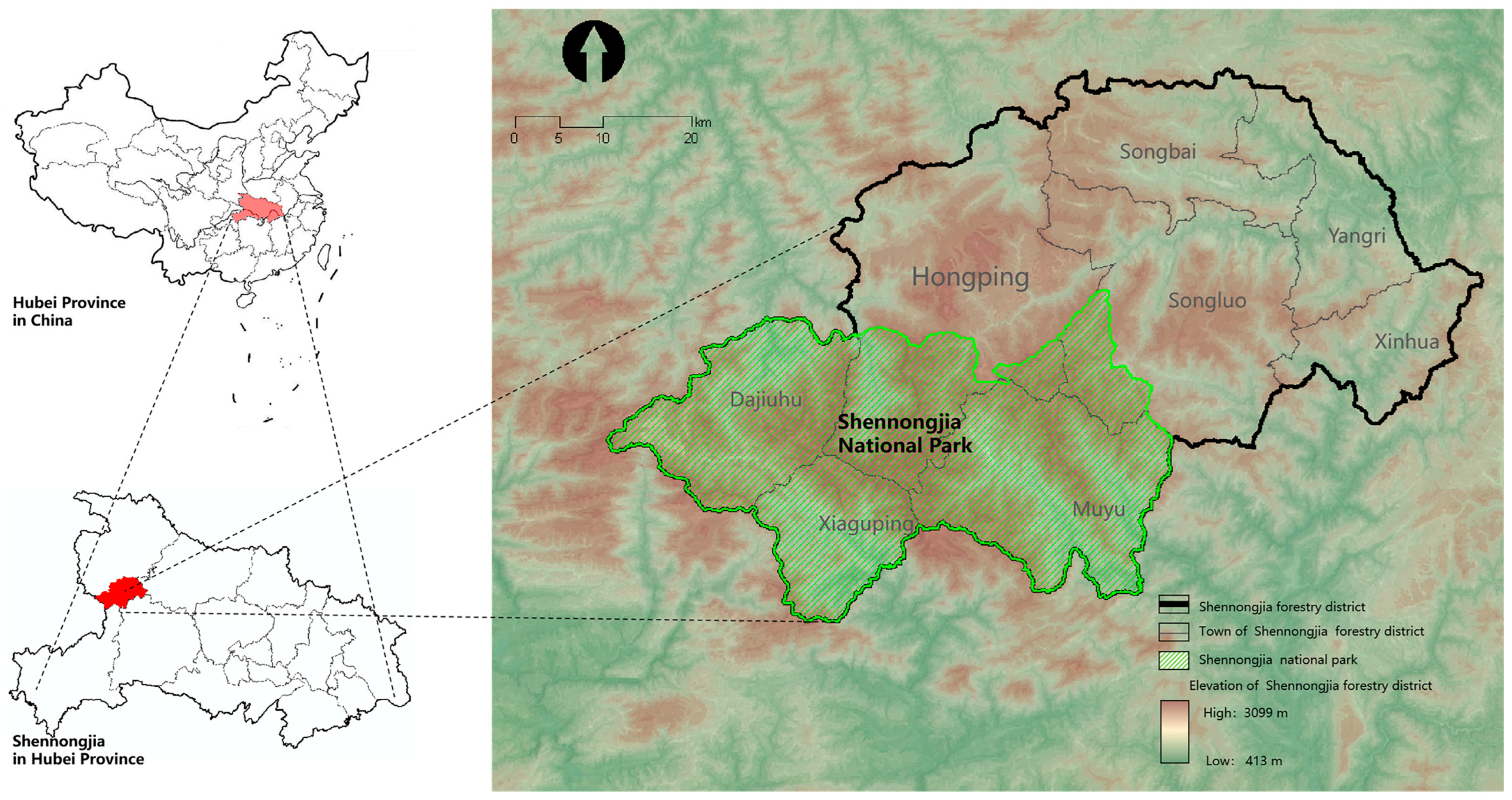
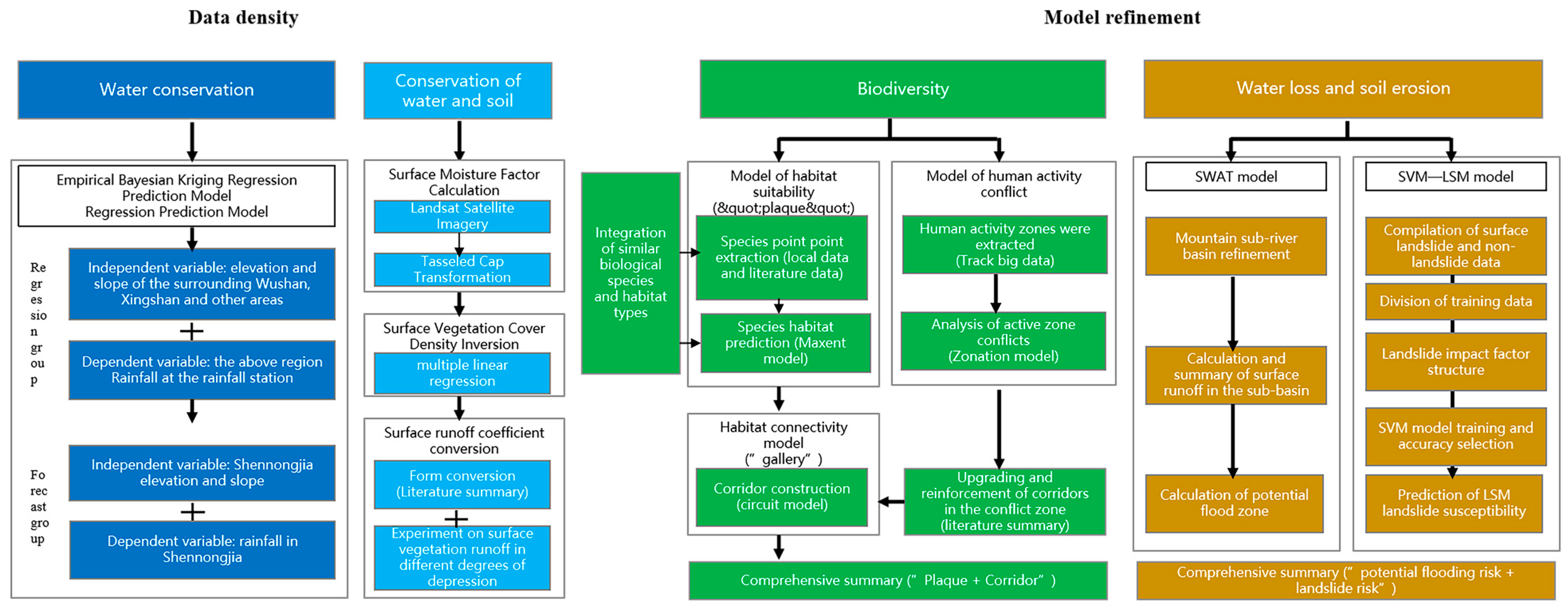
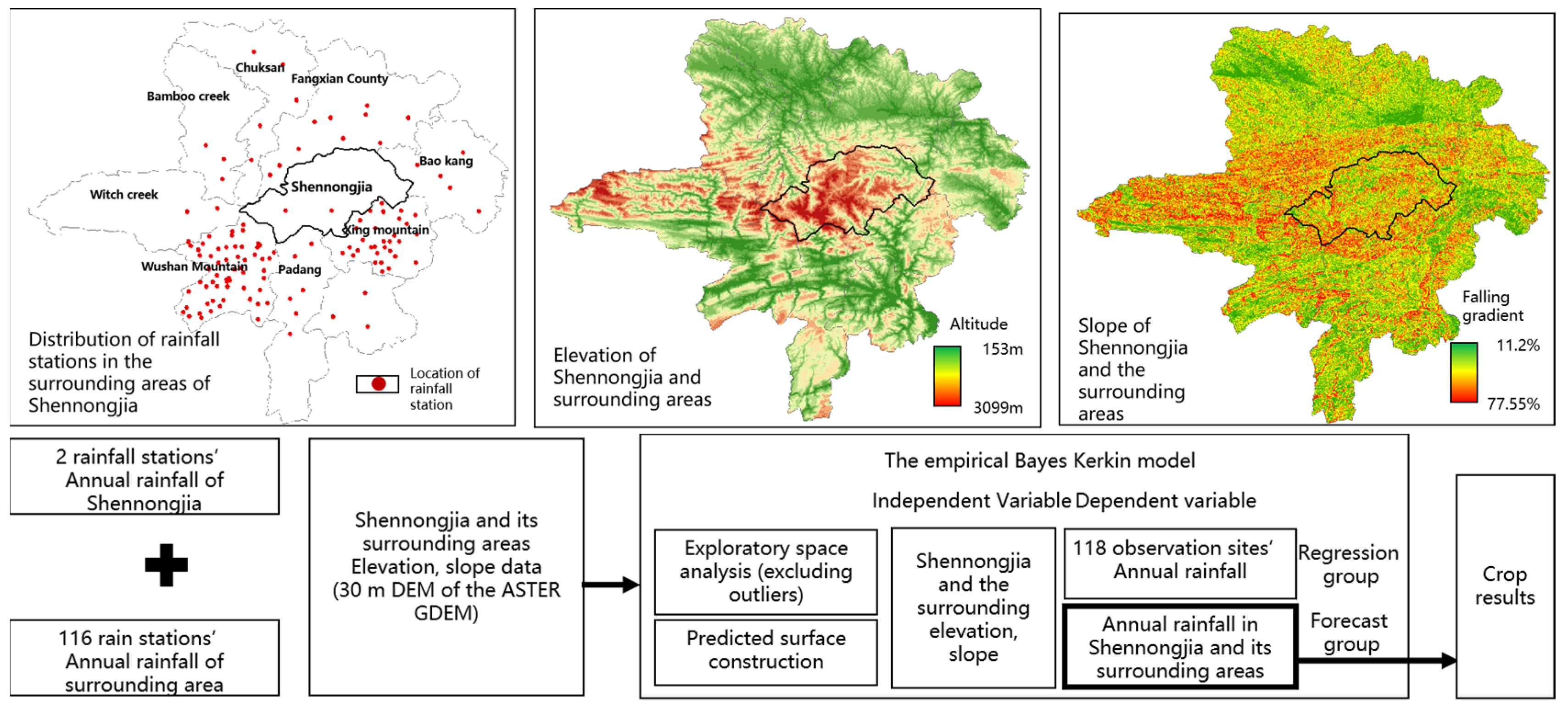

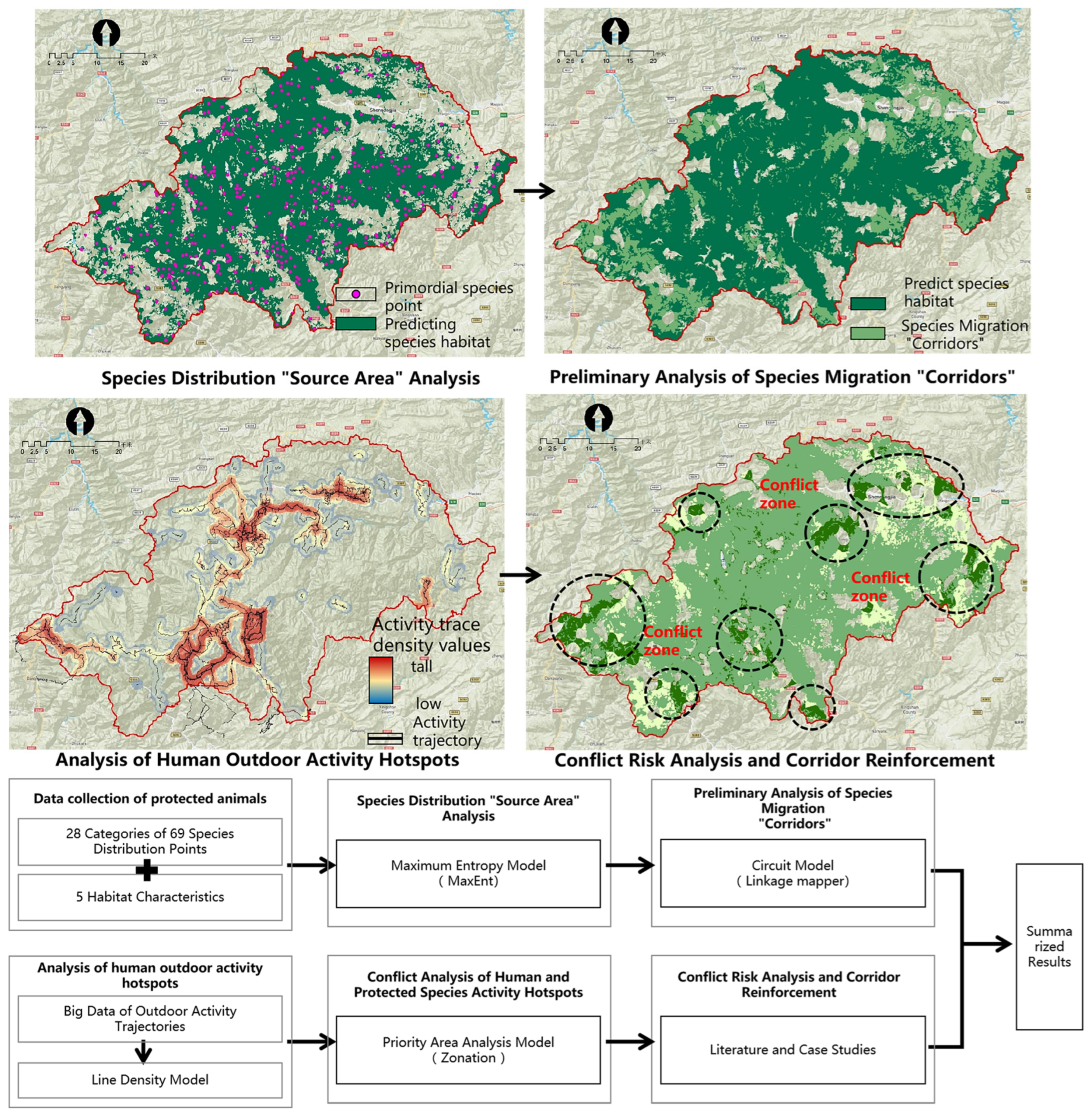
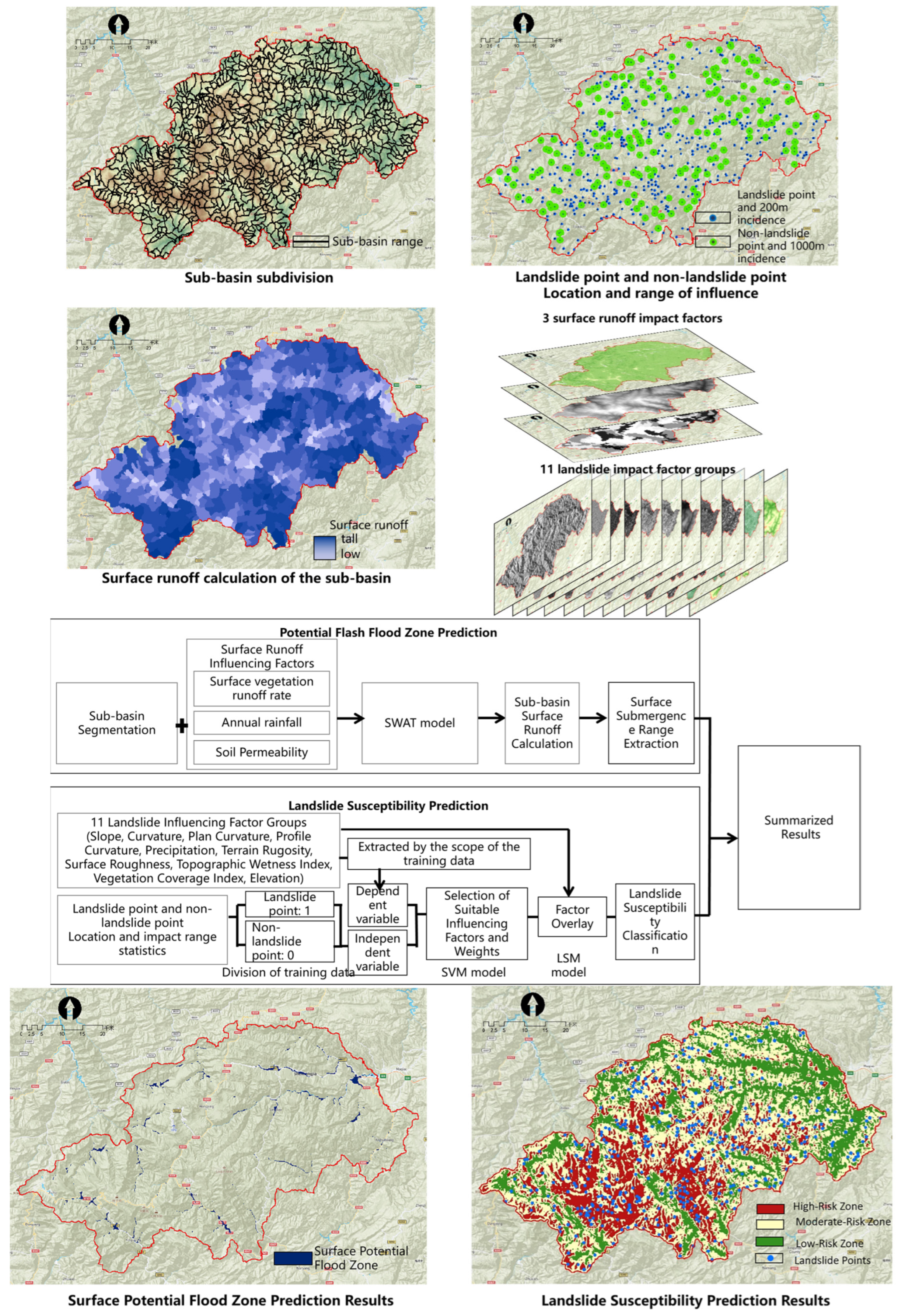
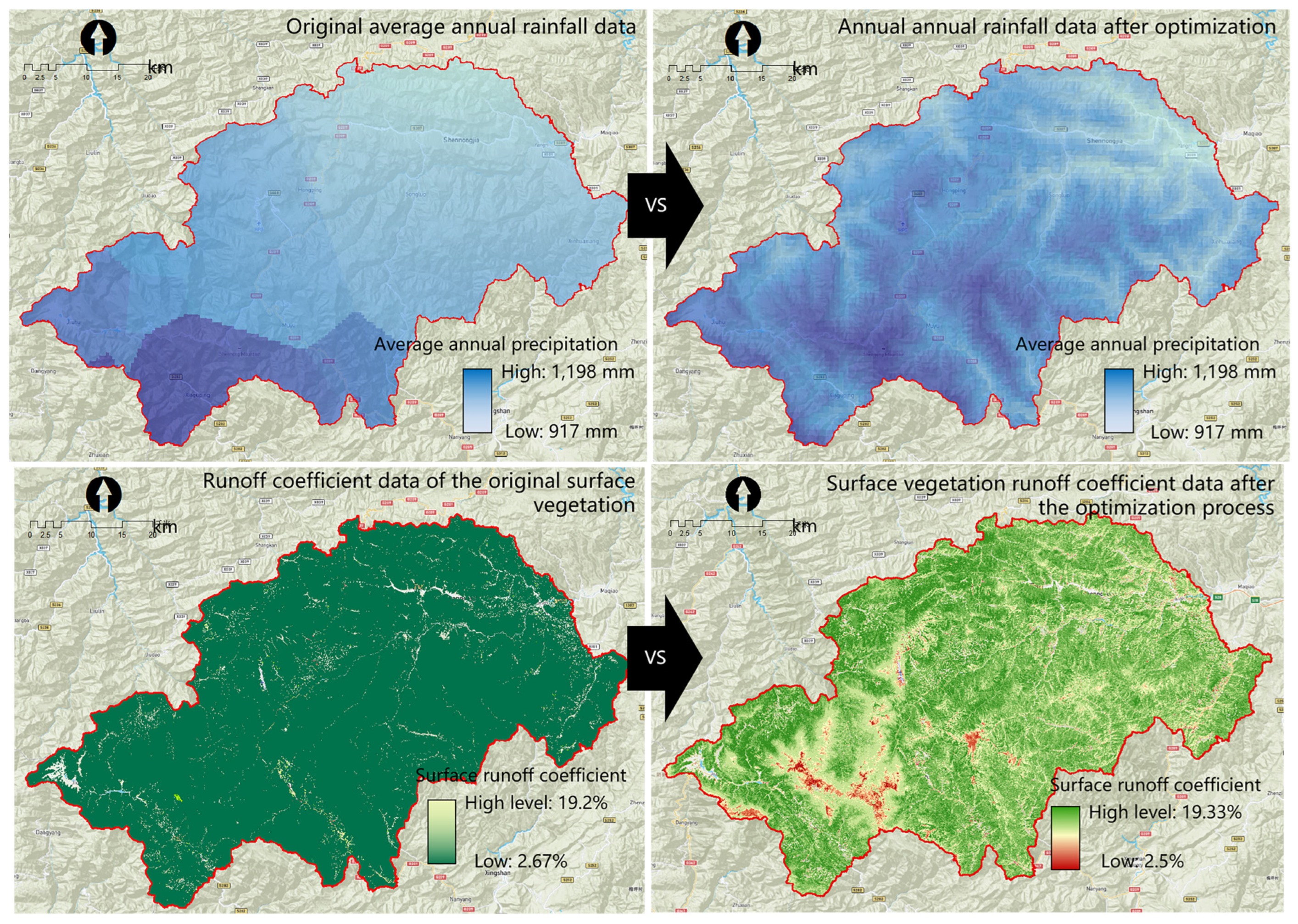
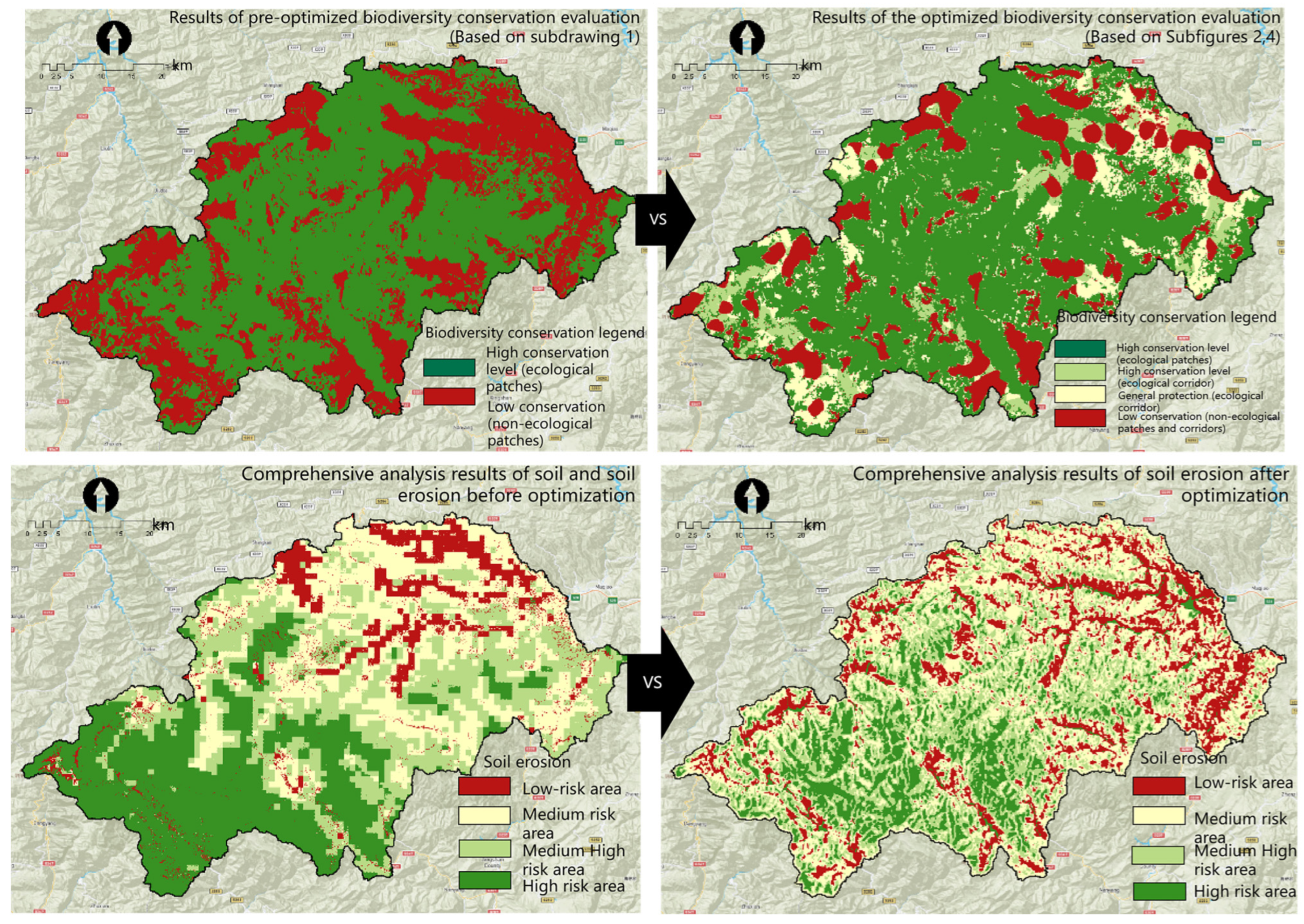

| Shennongjia Climate Zone Names and Elevation Ranges | Original Result | Optimized Result | ||
|---|---|---|---|---|
| Average Rainfall Within the Interval | Range Value of Rainfall Within the Interval | Average Rainfall Within the Interval | Range Value of Rainfall Within the Interval | |
| Low-mountain climate zone (500–1000 m) | 918 mm | 220.50 mm | 699 mm | 64.83 mm |
| Mid-mountain climate zone (1000–2000 m) | 1091 mm | 264.26 mm | 1017 mm | 62.46 mm |
| Subalpine climate zone (>2000 m) | 1463 mm | 193.51 mm | 1888 mm | 59.15 mm |
| Vegetation Density Intervals | Research by Niwat Ruangpanit [67] | Optimized Data Study | Absolute Difference Ratio |
|---|---|---|---|
| Corresponding Surface Runoff Coefficient Standards | Surface Runoff Coefficient Statistical Average | ||
| 20–30% | 19.33% | 22.14% | 14.5% |
| 40–50% | 15.16% | 16.03% | 5.7% |
| 50–60% | 11.35% | 13.12% | 15.6% |
| 60–70% | 7.36% | 7.86% | 6.8% |
| 70–80% | 4.88% | 5.13% | 5.1% |
| 80–90% | 2.22% | 2.15% | 3.2% |
Disclaimer/Publisher’s Note: The statements, opinions and data contained in all publications are solely those of the individual author(s) and contributor(s) and not of MDPI and/or the editor(s). MDPI and/or the editor(s) disclaim responsibility for any injury to people or property resulting from any ideas, methods, instructions or products referred to in the content. |
© 2025 by the authors. Licensee MDPI, Basel, Switzerland. This article is an open access article distributed under the terms and conditions of the Creative Commons Attribution (CC BY) license (https://creativecommons.org/licenses/by/4.0/).
Share and Cite
Zhou, X.; Huang, H.; Dai, S.; Zheng, D.; Zhao, J. Research on an Ecological Sensitivity Evaluation of Mountain-Type National Parks Under Multi-Modal Optimization: A Case Study of Shennongjia, China. Land 2025, 14, 923. https://doi.org/10.3390/land14050923
Zhou X, Huang H, Dai S, Zheng D, Zhao J. Research on an Ecological Sensitivity Evaluation of Mountain-Type National Parks Under Multi-Modal Optimization: A Case Study of Shennongjia, China. Land. 2025; 14(5):923. https://doi.org/10.3390/land14050923
Chicago/Turabian StyleZhou, Xingyu, Huan Huang, Shi Dai, Duanya Zheng, and Jie Zhao. 2025. "Research on an Ecological Sensitivity Evaluation of Mountain-Type National Parks Under Multi-Modal Optimization: A Case Study of Shennongjia, China" Land 14, no. 5: 923. https://doi.org/10.3390/land14050923
APA StyleZhou, X., Huang, H., Dai, S., Zheng, D., & Zhao, J. (2025). Research on an Ecological Sensitivity Evaluation of Mountain-Type National Parks Under Multi-Modal Optimization: A Case Study of Shennongjia, China. Land, 14(5), 923. https://doi.org/10.3390/land14050923





